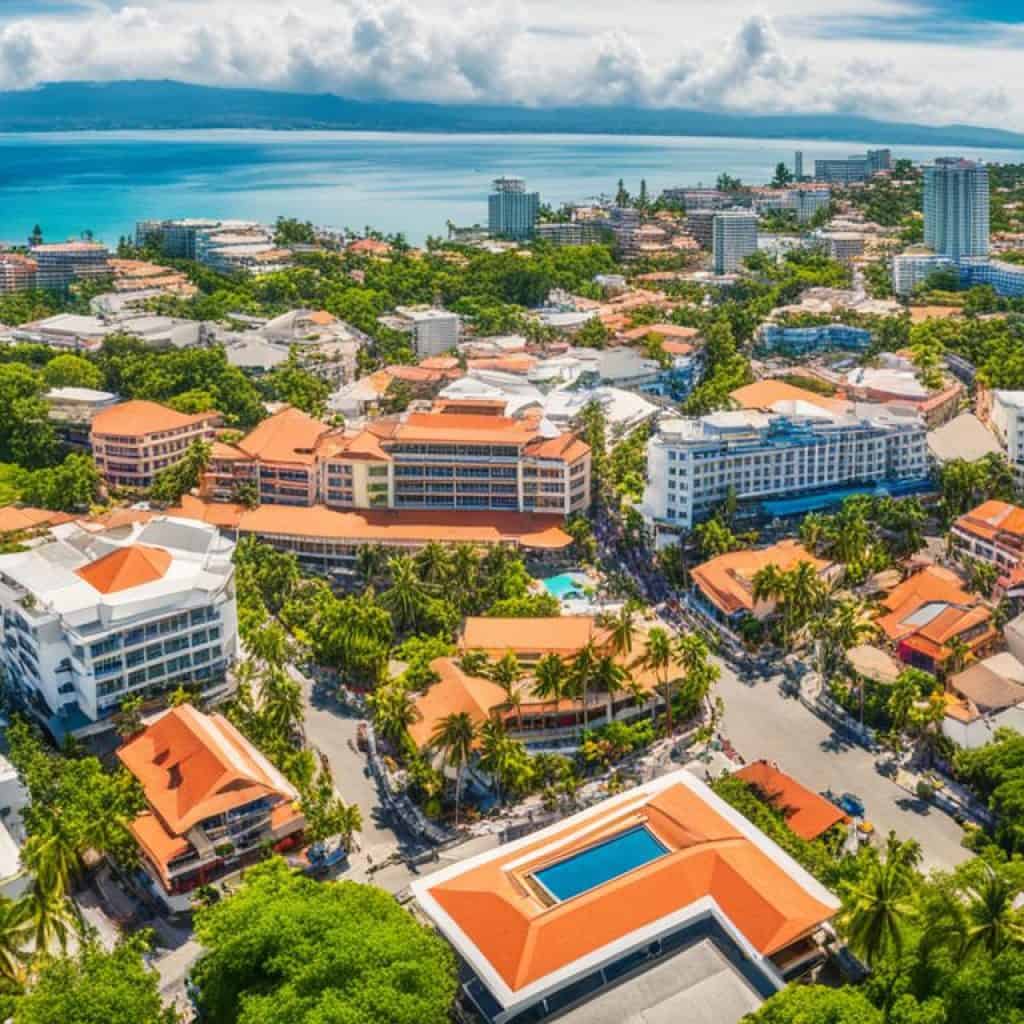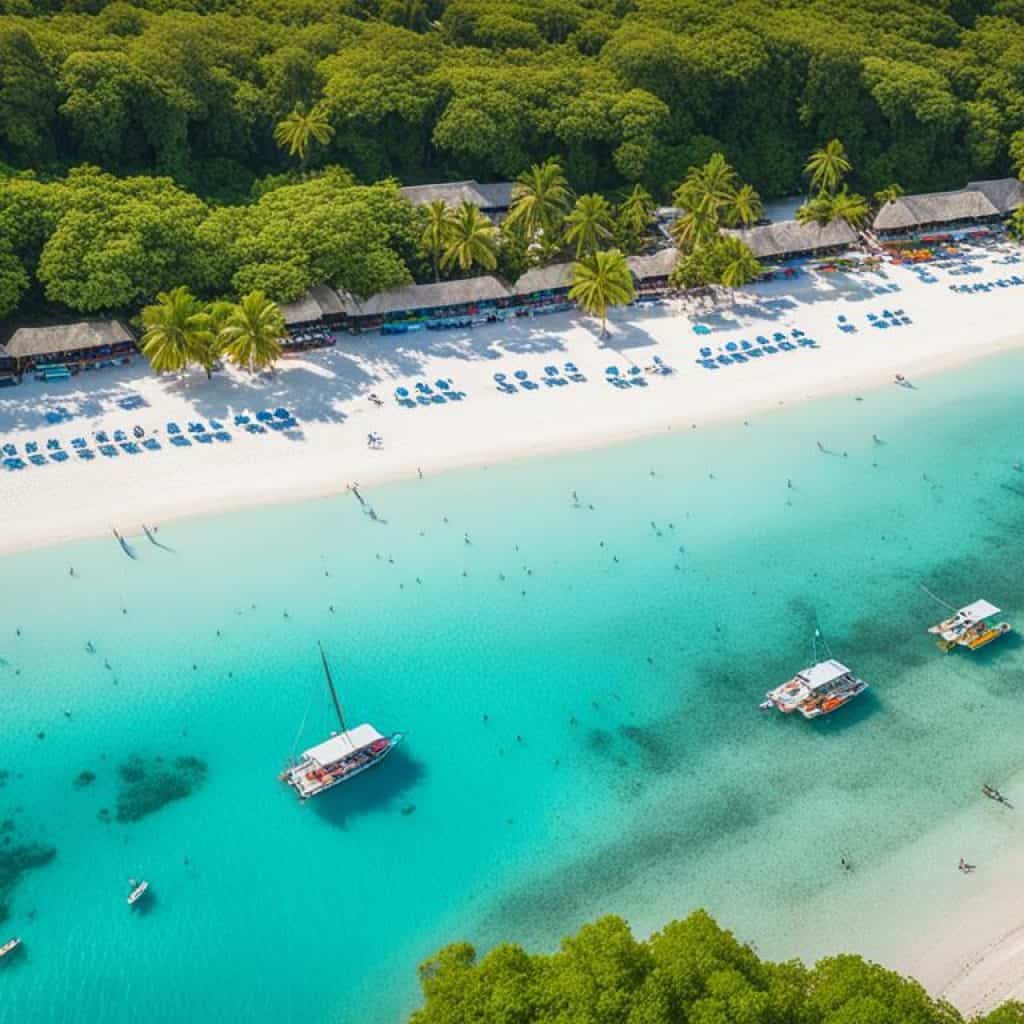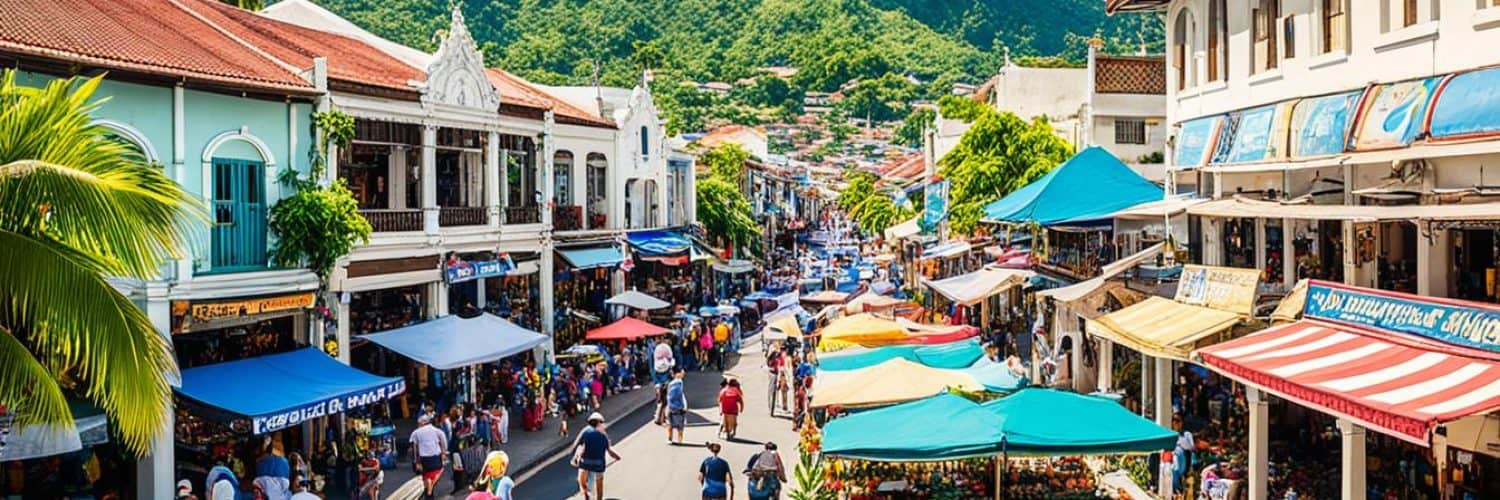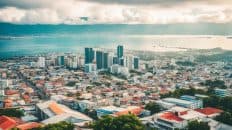Cebu, a popular tourist destination in the Philippines, is a treasure trove of charming towns that offer a delightful blend of culture, beauty, and adventure. From historical landmarks to pristine beaches, there is something for every traveler to explore and discover. Are you ready to embark on a journey through the must-visit cebu towns?
Key Takeaways:
- Discover the diverse charm of Cebu as we take you on a tour of its towns.
- Explore historical landmarks and immerse yourself in culture and tradition.
- Experience the natural beauty of beaches, mountains, and waterfalls.
- Indulge in delicious local cuisine and sample Cebu’s unique delicacies.
- Gain practical information and tips for a smooth and unforgettable trip to Cebu.
Best Time to Go to Cebu
Planning a trip to Cebu? It’s important to consider the best time to visit in order to make the most of your experience. The weather and climate of Cebu play a crucial role in determining the ideal time to travel, along with the renowned festivals that take place throughout the year.
The optimal time to visit Cebu is during the dry and summer season, which extends from December to May. During this period, you can expect warm and sunny weather perfect for outdoor activities such as swimming, diving, and sightseeing. The pleasant climate allows you to explore the charming towns and beautiful attractions of Cebu with ease.
One of the highlights of visiting Cebu is experiencing the Sinulog Festival, which is held in January. This vibrant cultural celebration showcases colorful street parades, traditional dances, and lively music, providing a unique opportunity to immerse yourself in the rich heritage of Cebu. Join in the festivities and witness the devotion and enthusiasm of the locals.
If you prefer to avoid large crowds and secure better deals on accommodation and transportation, consider planning your trip to Cebu from July to October. This is the low season, characterized by fewer tourists and more affordable prices. You can still enjoy the beauty of Cebu without the hustle and bustle, allowing for a more relaxed and intimate experience.
It’s important to note that Cebu can get crowded during holidays and Holy Week, so if you prefer a quieter and less crowded visit, it’s advisable to plan your trip accordingly.
To summarize, the best time to visit Cebu is during the dry and summer season from December to May, when you can enjoy favorable weather and engage in various outdoor activities. Don’t miss the opportunity to experience the Sinulog Festival in January, but if you prefer a quieter visit, consider traveling from July to October. Plan your trip accordingly and make unforgettable memories in the beautiful island province of Cebu.
How to Get to Cebu
Planning a trip to Cebu? Getting to this beautiful destination is easy, with various transportation options available.
Flights to Cebu
If you’re coming from within the Philippines or internationally, the most convenient way to reach Cebu is by air. The Mactan-Cebu International Airport is the main airport in Cebu and offers both domestic and international flights. Several airlines operate direct flights to Cebu from major cities in the Philippines and other countries.
Ferry to Cebu
Another option to get to Cebu is by ferry. There are regular ferry services that connect Cebu to other islands in the Philippines. If you prefer a scenic journey and have more time to spare, taking a ferry can be a delightful experience. The ferry terminals are conveniently located and provide easy access to different parts of Cebu.
Plan and Book in Advance
To ensure a smooth trip, it’s important to plan your itinerary and book your transportation in advance. Check the flight or ferry schedules, compare prices, and make your reservations ahead of time. This way, you can secure your preferred travel dates and avoid any last-minute hassle.
By choosing the best transportation option for your travel needs, you’ll be well on your way to exploring the wonders of Cebu.
| Transportation | Pros | Cons |
|---|---|---|
| Flights |
|
|
| Ferries |
|
|
Getting Around Cebu
Exploring the beautiful island of Cebu is made easy with an array of transportation options available to visitors. Whether you’re venturing into the city or exploring the countryside, Cebu offers a convenient and reliable public transportation system.
Cebu’s public transportation includes buses, taxis, and jeepneys, all of which provide efficient ways to navigate the island. Jeepneys, in particular, are a unique and iconic mode of transport in Cebu. These vibrant and colorfully decorated vehicles can be found throughout the city and are a popular choice among locals and tourists alike.
For those seeking a more convenient and comfortable option, taxis and ride-hailing services are readily available in Cebu. Taxis provide a hassle-free way to reach your destination, especially if you’re traveling with heavy luggage or prefer a more private mode of transportation.
When using public transportation in Cebu, it’s important to consider the traffic conditions, especially in the city areas. During peak hours, traffic congestion can occur, so it’s advisable to plan your journeys accordingly to avoid delays or plan for occasional traffic fluctuations.
In summary, getting around Cebu is a breeze with the variety of transportation options available. Whether you choose to ride in a colorful jeepney, hail a taxi, or utilize ride-hailing services, exploring this beautiful island has never been easier.
“The journey is part of the experience – an expression of the seriousness of one’s intent. One doesn’t take the A train to Mecca.”
Where to Stay in Cebu
Cebu offers a wide range of accommodations to suit every budget and preference. Whether you’re looking for budget accommodations, mid-range options, or luxurious stays, there are plenty of choices available. It’s important to consider the location and amenities offered when choosing where to stay in Cebu.
Budget Accommodations in Cebu
If you’re traveling on a tight budget, there are plenty of affordable options in Cebu. Hostels and guesthouses are popular choices among budget travelers. These accommodations provide basic amenities, comfortable beds, and communal spaces where you can meet fellow travelers and exchange stories. Some recommended budget accommodations in Cebu include:
- ABC Backpackers Hostel
- Mad Monkey Hostel Cebu City
- Escario Central Hotel
Mid-Range Accommodations in Cebu
If you’re looking for a bit more comfort and convenience, mid-range accommodations in Cebu are a great choice. These hotels and resorts offer comfortable rooms, amenities like swimming pools and fitness centers, and sometimes even complimentary breakfast. Some recommended mid-range accommodations in Cebu include:
- Quest Hotel and Conference Center – Cebu
- Radisson Blu Cebu
- Crimson Resort and Spa Mactan
Luxury Accommodations in Cebu
For those seeking a luxurious stay, Cebu has a range of high-end hotels and resorts that offer premium amenities and services. From breathtaking views to world-class dining options, these accommodations ensure a truly indulgent experience. Some recommended luxury accommodations in Cebu include:
- Shangri-La’s Mactan Resort & Spa
- Mövenpick Hotel Mactan Island Cebu
- The Henry Hotel Cebu
When choosing where to stay in Cebu, consider factors such as location, proximity to attractions, and the amenities that are important to you. Whether you opt for a budget hostel or a luxury resort, Cebu’s accommodations ensure a comfortable and memorable stay.

What to See and Do in Cebu City
As the capital of Cebu, Cebu City is a vibrant destination filled with historical and cultural attractions. Whether you’re a history enthusiast or simply looking to immerse yourself in the local culture, there are plenty of must-see attractions that will captivate your interest.
Fort San Pedro
An iconic landmark in Cebu, Fort San Pedro is a historic military defense structure that dates back to the Spanish colonial period. Built in the 16th century, this well-preserved fort offers a glimpse into the city’s past and provides stunning views of the surrounding area. Explore the fort’s walls, chambers, and gardens as you learn about its significance in Cebu’s history.
Basilica del Santo Niño
Basilica del Santo Niño is a Roman Catholic church that stands as a testament to Cebu’s deep religious roots. Inside the basilica, you’ll find the image of the Santo Niño, a revered religious artifact that symbolizes the Christianization of the Philippines. Pay a visit to this sacred site and experience the devotion of the local community.
Magellan’s Cross
Magellan’s Cross is a pivotal historical site in Cebu City. Planted by Ferdinand Magellan in 1521, this wooden cross marks the arrival of Christianity in the Philippines. The site is housed within a chapel and attracts both tourists and locals alike who seek to pay homage to this significant landmark.
Yap-Sandiego Ancestral House
The Yap-Sandiego Ancestral House is a beautifully preserved 17th-century house that offers a glimpse into Cebuano history and culture. Explore the intricate architecture, antique furniture, and historical artifacts as you step back in time and gain insight into the rich heritage of the region.
These attractions in Cebu City are just a glimpse into the historical and cultural wonders that await you. Explore the city’s captivating landmarks and immerse yourself in its vibrant history and traditions.
What to See and Do in North Cebu
North Cebu is a paradise for nature lovers and beach enthusiasts. This region offers beautiful island destinations that will take your breath away. Whether you’re seeking thrilling underwater adventures or simply wanting to relax on pristine white sand beaches, North Cebu has it all.
Malapascua Island
If you’re a diving enthusiast or love swimming in crystal clear waters, Malapascua Island is a must-visit destination. This island is famous for its thresher sharks, making it a top spot for diving enthusiasts. You can also unwind and bask in the beauty of its picturesque white sand beaches.
Bantayan Island
Bantayan Island is renowned for its pristine white sand beaches and crystal clear waters. It offers a peaceful and idyllic retreat for those seeking relaxation and tranquility. Unwind on the beaches, take a refreshing swim, or simply enjoy a leisurely walk along the coastline.
Camotes Island
Camotes Island is a hidden gem in North Cebu. It offers a wide range of activities for adventure seekers, including spelunking, cliff diving, and kayaking. Explore the island’s breathtaking caves, jump off cliffs into crystal clear waters, or embark on a kayaking adventure to discover hidden corners of its coastline.
Immerse yourself in the natural beauty of North Cebu and experience the wonders that these islands have to offer. Whether you’re exploring the depths of the ocean or simply basking in the sun on pristine beaches, North Cebu’s attractions are sure to leave a lasting impression.
| Attraction | Description |
|---|---|
| Malapascua Island | Known for thresher sharks and white sand beaches |
| Bantayan Island | Famous for pristine white sand beaches and crystal clear waters |
| Camotes Island | A hidden gem offering spelunking, cliff diving, and kayaking |
What to See and Do in South Cebu
South Cebu is a haven for nature lovers and adventure enthusiasts, offering a plethora of natural wonders and exciting activities. Whether you’re seeking spiritual solace, underwater excitement, breathtaking waterfalls, or stunning panoramic views, South Cebu has something for everyone.
Simala Shrine
One of the most revered pilgrimage sites in Cebu, the Simala Shrine attracts thousands of devotees each year. Located in Sibonga, this magnificent church is adorned with intricate architectural details and houses a sacred statue of the Virgin Mary. The serene atmosphere and spiritual significance make it a must-visit destination for religious travelers.
Moalboal Sardine Run
Prepare to be amazed by the mesmerizing spectacle of the Moalboal Sardine Run. Dive into the crystal-clear waters off Moalboal and witness millions of sardines swirling in unison, creating a breathtaking display of natural beauty. Snorkeling or scuba diving alongside these shimmering silver fish is an experience you’ll never forget.
Kawasan Falls
Escape to the tranquility of Kawasan Falls, a picture-perfect waterfall nestled amidst lush tropical jungles. Located in Badian, this multi-tiered cascade offers a refreshing oasis for a relaxing dip or a thrilling canyoneering adventure. Immerse yourself in the turquoise waters and let the roaring sound of the falls soothe your soul.
Osmeña Peak
Embark on a trek to Osmeña Peak, the highest point in Cebu, and be rewarded with panoramic vistas of the surrounding landscapes. Located in Dalaguete, this majestic mountain offers a challenging yet rewarding hike. Marvel at the rolling hills, verdant valleys, and breathtaking views of neighboring islands, proving that South Cebu is a nature lover’s paradise.
South Cebu is a treasure trove of natural wonders and thrilling adventures. From the spiritual sanctuary of Simala Shrine to the awe-inspiring Moalboal Sardine Run, the picturesque Kawasan Falls to the breathtaking views from Osmeña Peak, there’s no shortage of beauty and excitement in this region of Cebu. Immerse yourself in the grandeur of South Cebu and create memories that will last a lifetime.
What to Eat and Drink in Cebu
Cebu, a culinary paradise in the Philippines, offers a wide array of delectable dishes that showcase the rich flavors and vibrant culture of the region. From mouth-watering street food to delicious seafood delicacies, Cebu cuisine has something to satisfy every palate.
When visiting Cebu, one of the must-try dishes is the famous Cebu Lechon. This succulent roasted pig is delightfully crispy on the outside and incredibly tender on the inside. The combination of flavorful meat and perfectly seasoned skin makes it an absolute delight for any food lover.
Cebu is also known for its mouth-watering delicacies, such as dried mangoes and chicharon. The dried mangoes are a popular sweet treat that perfectly captures the tropical flavors of the Philippines. The chicharon, crispy deep-fried pork cracklings, are a crunchy and savory snack that pairs well with a cold beer.
If you’re a seafood enthusiast, don’t miss out on trying sutukil, a unique Cebuano dish. Sutukil is a delectable combination of grilled, boiled, and raw seafood, allowing you to savor the freshness and natural flavors of the ocean.
When exploring Cebu, there are numerous places to indulge in the local cuisine. From humble street food stalls to upscale restaurants, you’ll find a variety of dining options to suit your preferences. Some popular food destinations in Cebu include the bustling Larsian BBQ and the iconic Zubuchon, known for their mouthwatering lechon.
So, if you’re a food lover looking to tantalize your taste buds, Cebu is the perfect destination. Embark on a culinary adventure and discover the flavors that make Cebu’s cuisine truly special.
Practical Information and Tips
Before traveling to Cebu, it’s important to be aware of some practical information and tips. This section will provide you with the necessary details to ensure a smooth and enjoyable trip.
Cebu Travel Tips
- Carry cash: While credit cards are widely accepted, it’s advisable to have some cash on hand as some establishments may not accept cards.
- Stay hydrated: Cebu can get hot and humid, so it’s essential to drink plenty of water and stay hydrated throughout the day.
- Use sunscreen: Protect your skin from the tropical sun by applying sunscreen with a high SPF rating.
- Practice basic safety precautions: Like any other travel destination, it’s important to stay vigilant and be aware of your surroundings. Keep your belongings secure and avoid displaying expensive items.
Cebu Practical Information
Currency: The official currency in Cebu is the Philippine Peso (PHP). It’s advisable to exchange some currency upon arrival or withdraw cash from ATMs. Major credit cards are accepted in most establishments.
Language: English is widely spoken in Cebu, especially in tourist areas. However, it can be helpful to learn a few basic phrases in Tagalog or Cebuano, the local languages, to facilitate communication with locals and immerse yourself in the local culture.
Knowing these practical tips and information will contribute to a hassle-free and enjoyable experience during your visit to Cebu. Now let’s move on to exploring the captivating attractions and unique experiences this beautiful destination has to offer.
Sample Itinerary in Cebu
To make the most of your trip to Cebu, here’s a sample 6-day itinerary that covers the highlights of the province:
- Day 1: Mactan Island-Hopping + Sightseeing
- Take a boat tour to explore the beautiful islands surrounding Mactan
- Visit attractions such as the Mactan Shrine and Lapu-Lapu Statue
- Take a ferry to Camotes Island
- Explore the pristine beaches and crystal-clear waters
- Visit attractions like Lake Danao and Buho Rock
- Start your day with a visit to Lake Danao, a scenic freshwater lake
- Drive back to Cebu City
- Explore the city’s historical landmarks, such as Fort San Pedro and Magellan’s Cross
- Embark on a city sightseeing tour to visit popular attractions like the Basilica del Santo Niño and Tops Lookout
- Indulge in a delicious feast of Cebu’s famous lechon
- Immerse yourself in the vibrant atmosphere of Cebu City
- Experience the breathtaking sardine run in Moalboal
- Try canyoneering in the stunning canyons of Badian
- Swim in the turquoise waters of Kawasan Falls
- Visit iconic churches and temples in Cebu City, such as the Taoist Temple and Cebu Metropolitan Cathedral
- Explore the religious heritage of Cebu
This itinerary allows you to experience the diverse attractions of Cebu, from stunning islands and natural wonders to historical landmarks and delicious cuisine. Don’t forget to sample the famous Cebu lechon along the way!
Discover the Unique Attractions in Cebu
In addition to the well-known tourist spots, Cebu also offers a variety of unique attractions that are off the beaten path. These hidden gems provide visitors with the opportunity to explore undiscovered Cebu spots and experience something truly special. Whether you’re seeking picturesque landscapes or intriguing cultural sites, Cebu has it all.
Sirao Flower Garden: A Vibrant Delight
One of the unique attractions in Cebu is the Sirao Flower Garden, also known as the “Little Amsterdam” of Cebu. This stunning garden is adorned with vibrant flowers and features a windmill, creating a picturesque and romantic ambiance. Walking through the rows of colorful blooms is a delightful experience that will transport you to a different world.
The 10,000 Roses of Cebu: A Dazzling Display
Another must-visit attraction in Cebu is the 10,000 Roses. This enchanting display features artificial LED-powered roses that light up at night, creating a mesmerizing sight. The combination of the roses and the surrounding landscape makes for a magical and unforgettable experience.
Mantayupan Falls, Dao Falls, and Carnaza Island: Natural Treasures
If you’re an adventure seeker looking for off-the-beaten-path destinations in Cebu, make sure to visit Mantayupan Falls, Dao Falls, and Carnaza Island. Mantayupan Falls is a majestic waterfall that cascades down from a height of over 200 feet, offering a refreshing swimming experience in its crystal-clear waters. Dao Falls, located in Samboan, is a hidden gem nestled amidst lush greenery and is known for its pristine beauty. Carnaza Island, situated in the northern part of Cebu, is an undiscovered paradise boasting white sandy beaches, turquoise waters, and stunning cliffs.
These lesser-known attractions in Cebu provide a unique and authentic experience for travelers who wish to explore beyond the usual tourist spots. Whether you’re admiring vibrant flowers at the Sirao Flower Garden, marveling at the artificial LED-powered roses at the 10,000 Roses of Cebu, or immersing yourself in the natural wonders of Mantayupan Falls, Dao Falls, and Carnaza Island, you’ll discover the true beauty that Cebu has to offer.
Explore the Wonders of Cebu’s Natural Beauty
Cebu, a stunning destination in the Philippines, is truly blessed with natural beauty that will take your breath away. From picturesque beaches to captivating waterfalls and majestic mountains, Cebu offers a diverse range of natural attractions to explore.
Beautiful Beaches in Cebu
One of the highlights of Cebu’s natural beauty is its pristine beaches. Some of the must-visit beaches include:
- Malapascua Beach: This idyllic beach in northern Cebu is renowned for its crystal-clear waters and powdery white sand. It’s also a popular spot for snorkeling and diving, offering vibrant coral reefs and the chance to encounter thresher sharks.
- Bantayan Beach: Located on Bantayan Island, this beach is a tropical paradise with its turquoise waters and palm-fringed shores. It’s the perfect spot to relax, unwind, and soak up the sun.
- Moalboal Beach: Moalboal is famous for its underwater wonders, including a vibrant coral reef and a thriving marine life. The beach offers fantastic snorkeling and diving opportunities, where you can swim alongside colorful tropical fish.

Refreshing Waterfalls in Cebu
If you’re a nature lover, Cebu’s waterfalls will captivate you with their beauty and tranquility. Make sure to visit the following waterfalls:
- Kawasan Falls: Located in Badian, Kawasan Falls is a multi-tiered waterfall that cascades into a series of turquoise-colored natural pools. Take a refreshing dip or go canyoneering to experience an adrenaline-pumping adventure.
- Tumalog Falls: Situated in Oslob, Tumalog Falls is a mesmerizing waterfall known for its thin, delicate streams of water. The falls create a misty atmosphere, which makes it a magical place to visit.
Majestic Mountains in Cebu
Cebu is also home to majestic mountains that offer breathtaking views and unforgettable hiking experiences. Don’t miss these mountain peaks:
Osmena Peak: Rising 1,013 meters above sea level, Osmena Peak offers panoramic views of Cebu’s southern countryside. The jagged peaks and rolling hills create a picturesque landscape, making it a favorite spot for hikers and nature enthusiasts.
Embark on an adventurous hike up Osmena Peak and witness the stunning sunrise or sunset painting the sky with vibrant hues.
With its stunning beaches, enchanting waterfalls, and awe-inspiring mountains, Cebu truly offers a natural playground for outdoor enthusiasts and nature lovers. Immerse yourself in the wonders of Cebu’s natural beauty and create memories that will last a lifetime.
Immerse Yourself in Cebu’s Rich History and Culture
Cebu, a province in the Philippines, boasts a fascinating history and vibrant culture that can be explored through its historical landmarks and museums. From religious sites to colonial houses, Cebu offers a glimpse into its past and showcases its unique heritage.
The Magellan’s Cross and Basilica del Sto. Niño
One of the most significant historical sites in Cebu City is the Magellan’s Cross, located near the Basilica del Sto. Niño. This iconic cross, planted by Ferdinand Magellan in 1521, symbolizes the arrival of Christianity in the Philippines. Nearby, the Basilica del Sto. Niño is a grand Roman Catholic church that houses the revered image of the Santo Niño, a representation of the child Jesus.
The Yap-Sandiego Ancestral House and Casa Gorordo Museum
For a more immersive experience of Cebu’s colonial past, visit the Yap-Sandiego Ancestral House and the Casa Gorordo Museum. The Yap-Sandiego Ancestral House is a well-preserved 17th-century house that showcases Cebuano history and culture through its antique furniture, artifacts, and architectural design. The Casa Gorordo Museum, on the other hand, offers a glimpse into the lifestyle of a 19th-century Cebuano family and displays a collection of historical and cultural artifacts.
Fort San Pedro and The Heritage of Cebu Monument
Another must-visit historical landmark in Cebu City is Fort San Pedro. Built by the Spanish in the 16th century, this triangular fortress served as a defense against pirates and invaders. Today, it houses a museum that exhibits artifacts and relics from the Spanish colonial period. Nearby, The Heritage of Cebu Monument is a stunning tableau that depicts key moments in Cebu’s history, including the arrival of Ferdinand Magellan and the conversion of the Cebuanos to Christianity.
Immerse Yourself in Cebu’s Vibrant Culture
Cebu’s culture comes alive through its festivals, music, and arts. The Sinulog Festival, held annually in January, is a grand celebration honoring the Santo Niño. This colorful and lively event features street dances, parades, and religious processions. Other festivals like the Kadaugan sa Mactan and Pasko sa Sugbo showcase the rich cultural traditions and local talents of Cebuanos. To experience traditional music and arts, you can attend performances at the Cebu Provincial Capitol or visit the Taboan Public Market, known for its handicrafts and souvenirs.
Exploring Cebu’s historical landmarks and immersing yourself in its vibrant culture is a rewarding experience that allows you to connect with the roots and heritage of this beautiful province.
Conclusion
Cebu is truly a treasure trove of attractions, offering a mix of natural beauty, rich history, and vibrant culture. Whether you’re exploring the charming towns, diving into the crystal-clear waters, or indulging in the delicious cuisine, Cebu has something for every traveler.
This tourist’s guide has provided you with an overview of the must-visit cebu towns, practical information, and itinerary suggestions to help you plan your trip to this stunning destination. From the historical landmarks and museums in Cebu City to the pristine beaches and natural wonders in North and South Cebu, there are endless opportunities for adventure and exploration.
Discover the wonders of Cebu and create unforgettable memories as you immerse yourself in its diverse landscapes, rich history, and vibrant culture. Whether you’re seeking relaxation, adventure, or a deeper understanding of Filipino heritage, Cebu has it all. Plan your trip, pack your bags, and get ready to embark on an unforgettable journey in the beautiful province of Cebu.


















Add comment